The first sign of a melanoma is usually an unusual or funny-looking mole or freckle. Look out for:
- Change in the colour, shape or size of a spot
- A spot that is itchy, painful or tender
- One that stands out from other spots – an “ugly duckling”
If you find an “ugly duckling” on your skin, see your doctor right away.
| Superficial spreading melanoma | Lentigo maligna melanoma | Superficial spreading melanoma | Nodular melanoma |
|---|---|---|---|
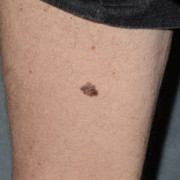 |
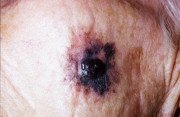 |
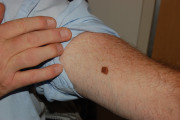 |
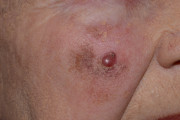 |
- See more images of superficial spreading melanoma
- See more images of lentigo maligna melanoma
- See more images of nodular melanoma
Moles and freckles
Most moles, spots, freckles and bumps on the skin are harmless, but this is not always the case:
- About 75% of melanoma are new spots that appear in normal skin – a new ugly duckling.
- Other melanomas start within an existing mole or freckle – watch out for change.
Normal moles
Most people have several normal moles on their skin and a few people have lots of them. These ‘normal moles' are also called melanocytic naevi because they are made up of melanocyte cells. Normal moles may be flat or raised and vary in colour from pink to brown or black. The colour depends on how much pigment or melanin is made by the melanocytes. They are mostly round or oval shaped but can sometimes be odd shaped. They can be tiny spots or up to several centimetres in size.
Normal moles are harmless but in some cases a melanoma may start from within them. People with lots of moles, especially those with over 100 moles, are at greater risk of getting melanoma than those with few moles. If you start to notice any changes in a mole, it’s best to get it checked out by a doctor.
Funny-looking moles
Funny-looking moles are also called atypical naevi or dysplastic naevi. These moles are basically normal moles with some unusual features such as large size or an odd shape with blurred edges or a flat and bumpy surface. Funny-looking moles may look like melanoma but are actually harmless (benign) spots that don’t need to be removed. However, if you have a few, particularly five or more of these funny-looking moles, your chance of getting a melanoma is increased. If you are unsure about any of your funny-looking moles it’s best to get them checked out.
Brown spots and freckles
Freckles are small flat brown marks that most often appear on the face and other exposed parts of the body in the summer months. They are most often seen in fair-skinned people with red hair but can be seen in people with darker skin colour too. Freckles are formed when the skin is exposed to the sun. Freckles are harmless, but if one starts to look funny compared to others then it’s best to get it checked out.
Larger, flat, brown spots on the face and hands that start to appear in middle-aged people, known as age spots or liver spots, are properly called solar lentigines. These occur in people of all skin types if they have spent too much time exposed to the sun. Solar lentigines are harmless too but because they can sometimes turn into melanoma it is good to get them checked out, especially if they start to change colour or shape.
Seborrhoeic keratoses
Seborrhoeic keratoses grow in number as we get older. Most people over 40 have at least one of these warty spots, and some people have hundreds. They are stuck on to the skin rather like barnacles and can be clustered around the neck or under the breasts, or scattered all over the body. They can be any colour including white, yellow, brown and black. Seborrhoeic keratoses can be irritating, but are actually harmless. If in doubt – check it out!
| Normal moles | Atypical naevi | Solar lentigines | Seborrhoeic keratoses |
|---|---|---|---|
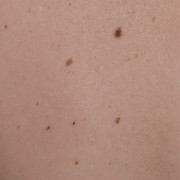 |
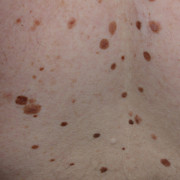 |
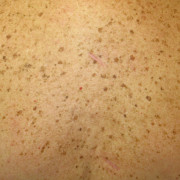 |
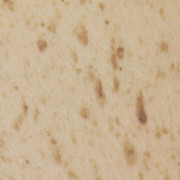 |
- See more images of atypical naevi
- See more images of solar lentigines
- See more images of seborrhoeic keratoses
Other types of skin cancer
When looking for the 'ugly duckling’ spot, you may discover an actinic keratosis or another type of skin cancer such as basal cell carcinoma or squamous cell carcinoma. Look out for:
- A growing spot that is rough, dry or scaly
- A spot that has become a thickened and raised bump
- A spot or sore that bleeds easily or is crusted over
- A sore that doesn’t heal
See your doctor to confirm the diagnosis and find out treatment options.
| Actinic keratosis | Basal cell carcinoma | Basal cell carcinoma | Squamous cell carcinoma |
|---|---|---|---|
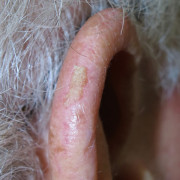 |
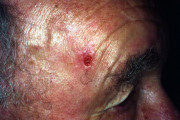 |
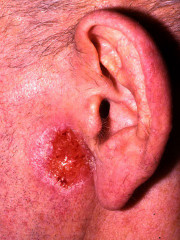 |
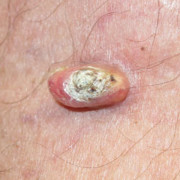 |